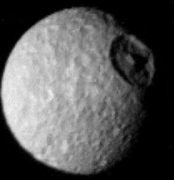Saturn's Moons

Saturn has 31 known moons. Of them, Titan is the largest,
and is the second-largest in our solar system (Jupiter's Ganymede is
largest). The other satellites have icy surfaces and many craters. Mimas
has one crater that spans one quarter of it's diameter. Iapetus is another
which is an enigma. It's surface appears to be divided into two sections.
Most of the moons, which are small, were probably captured asteroids, and
did not form with Saturn.
Pan is the closest satellite to Saturn. That is about all
that we know about it.
 Next
comes Atlas. Atlas serves a very important function: Its orbit is at the
edge of Saturn's A-ring, and Atlas keeps the A-ring in place, so the particles
cannot go beyond its orbit. Next
comes Atlas. Atlas serves a very important function: Its orbit is at the
edge of Saturn's A-ring, and Atlas keeps the A-ring in place, so the particles
cannot go beyond its orbit.
Next out are Prometheus (right) and Pandora. Prometheus
and Pandora serve a joint purpose which is not unlike Atlas: Prometheus guards
the inside of the F-ring, while Pandora guards the outside.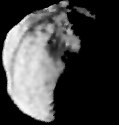
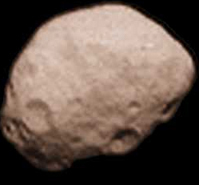 Next
come Epimetheus (left) and Janus (right). Scientists think that these two
moons were once part of a single moon that was later blasted apart. This
claim is supported by the fact that their orbits are within thirty miles
of each other. Next
come Epimetheus (left) and Janus (right). Scientists think that these two
moons were once part of a single moon that was later blasted apart. This
claim is supported by the fact that their orbits are within thirty miles
of each other.
Next comes Mimas. This is a unique moon because it has a
huge crater that covers fully one quarter of its entire surface. It is often
thought to look like the "Death Star" from the popular movie and
book series Star Wars.
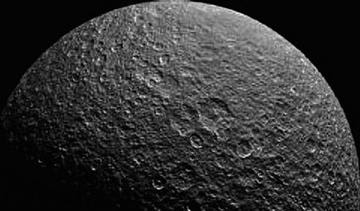 Next
out are Enceladus, Tethys, Telesto, Calypso, Helene, Dione, and Rhea (right).
Dione looks very much like our moon, except that it contains ice. Tethys,
Telesto, and Calypso all share the same orbit. Next
out are Enceladus, Tethys, Telesto, Calypso, Helene, Dione, and Rhea (right).
Dione looks very much like our moon, except that it contains ice. Tethys,
Telesto, and Calypso all share the same orbit.
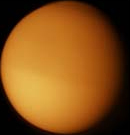 Titan
(left) is the second-largest moon in the solar system. It is also one of
the only three that have an atmosphere (Jupiter's Io and Neptune's Triton are
the other two). Out of the other two, Titan certainly has the thickest. In
fact, its clouds are so thick that the moon is like Venus;
it is impossible to see the ground. Therefore, we know very little about
this moon, except it has a thick orange cloud-cover, and an atmosphere thicker
than Earth's. Titan
(left) is the second-largest moon in the solar system. It is also one of
the only three that have an atmosphere (Jupiter's Io and Neptune's Triton are
the other two). Out of the other two, Titan certainly has the thickest. In
fact, its clouds are so thick that the moon is like Venus;
it is impossible to see the ground. Therefore, we know very little about
this moon, except it has a thick orange cloud-cover, and an atmosphere thicker
than Earth's.
The next three moons are Hyperion, Iapetus, and Phoebe.
Hyperion looks like a hamburger, and has a crater that covers one third of
its bottom side. Iapetus has one side that reflects light, but the other
side is covered in a pitch-dark material.
The other 13 moons all orbit outside of Iapetus' orbit,
but a few are inside of Phoebe's. They were discovered in 2000 by a team
of astronomers who were examining old photographs of Saturn and the area
around Saturn. They are tiny, and some orbit retrograde,
meaning that they orbit in the direction opposite the planet's spin - an
almost certain indication that they are captured asteroids rather than being
native to the system. They are currently being called S/2000 S#, with the
# ranging from 1 to 12, and S/2003 S1. They will eventually be given names
by the International Astronomical
Union, the only official naming group.
|
|
|
|
|
|
|
|
|
|
| Mimas (SI) |
1789 |
W. Herschel |
185.52 |
0.375 |
209 x 196 x 191 |
0.9424218 |
0.5 |
1.53 |
0.0202 |
| Enceladus (SII) |
1789 |
W. Herschel |
238.02 |
0.65 |
256 x 247 x 245 |
1.370218 |
1.0 |
0.00 |
0.0045 |
| Tethys (SIII) |
1684 |
G. Cassini |
294.66 |
6.27 |
536 x 528 x 526 |
1.887802 |
0.9 |
1.86 |
0.0000 |
| Dione (SIV) |
1684 |
G. Cassini |
377.40 |
11.0 |
560 |
2.736915 |
0.7 |
0.02 |
0.0022 |
| Rhea (SV) |
1672 |
G. Cassini |
527.04 |
23.1 |
764 |
4.517500 |
0.7 |
0.35 |
0.0010 |
| Titan (SVI) |
1655 |
C. Huygens |
1221.83 |
1345.5 |
2575 |
15.945421 |
0.22 |
0.33 |
0.0292 |
| Hyperion (SVII) |
1848 |
W. Bond |
1481.1 |
0.2 |
185 x 140 x 113 |
21.276609 |
0.3 |
0.43 |
0.1042 |
| Iapetus (SVIII) |
1671 |
G. Cassini |
3561.3 |
15.9 |
718 |
79.330183 |
0.05 / 0.5 |
14.72 |
0.0283 |
| Pan (SXVIII, S/1981 S13) |
1990 |
M. Showalter |
133.583 |
0.00003 |
10 |
0.5750 |
0.5 |
0.0 |
0.000 |
| Atlas (SXV, S/1980 S28) |
1980 |
R. Terrile |
137.670 |
0.0001 |
18.5 x 17.2 x 13.5 |
0.6019 |
0.8 |
0.3 |
0.000 |
| Prometheus (SXVI, S/1980 S27) |
1980 |
S. Collins |
139.353 |
0.0033 |
74 x 50 x 34 |
0.6130 |
0.5 |
0.0 |
0.0024 |
| Pandora (SXVII, S/1980 S26) |
1980 |
S. Collins |
141.700 |
0.0020 |
55 x 44 x 31 |
0.6285 |
0.7 |
0.0 |
0.0042 |
| Epimetheus (SXI, S/1980 S3) |
1966 |
R. Walker |
151.422 |
0.0054 |
69 x 55 x 55 |
0.6942 |
0.8 |
0.34 |
0.009 |
| Janus (SX, S/1980 S1) |
1966 |
A. Dollfus |
151.472 |
0.0192 |
97 x 95 x 77 |
0.6945 |
0.9 |
0.14 |
0.007 |
| Methone (SXXXII, S/2004 S1) |
2004 |
|
194 |
|
3 |
1.01 |
|
|
|
| Pallene (SXXXIII, S/2004 S2) |
2004 |
|
211 |
|
4 |
1.14 |
|
|
|
| Calypso (SXIV, S/1980 S25) |
1980 |
B. Smith |
294.66 |
0.00004 |
15 x 8 x 8 |
1.8878 |
1.0 |
0 |
0 |
| Telesto (SXIII, S/1980 S13) |
1980 |
B. Smith |
294.66 |
0.00007 |
15 x 12.5 x 7.5 |
1.8878 |
1.0 |
0 |
0 |
| Helene (SXII, S/1980 S6) |
1980 |
Laques and Lecacheux |
377.40 |
0.0003 |
18 x 16 x 15 |
2.7369 |
0.7 |
0.0 |
0.005 |
| Polydeuces (SXXXIV, S/2004 S5) |
2004 |
|
377.40 |
|
4 |
2.74 |
|
|
|
| Kiviuq (SXXIV, S/2000 S5) |
2000 |
International Team of 8 Astronomers |
11,370 |
|
7 |
449 |
0.06 |
48.7 |
0.33 |
| Ijiraq (SXXII, S/2000 S6) |
2000 |
International Team of 8 Astronomers |
11,440 |
|
5 |
451 |
0.06 |
49.1 |
0.32 |
| Phoebe (SIX) |
1898 |
W. Pickering |
12,952 |
0.072 |
115 x 110 x 105 |
550.48* |
0.08 |
175.3 |
0.1633 |
| Paaliaq (SXXI, S/2000 S2) |
2000 |
International Team of 8 Astronomers |
15,200 |
|
10 |
687 |
0.06 |
47.2 |
0.36 |
| Skathi (SXXVII, S/2000 S8) |
2000 |
International Team of 8 Astronomers |
15,650 |
|
3 |
729* |
0.06 |
148.5 |
0.27 |
| Albiorix (SXXVI, S/2000 S11) |
2000 |
Gladman, et. al |
16,390 |
|
13 |
738 |
0.06 |
34.0 |
0.48 |
| Erriapo (SXXVIII, S/2000 S10) |
2000 |
International Team of 8 Astronomers |
17,610 |
|
4 |
871 |
0.06 |
33.5 |
0.47 |
| Siarnaq (SXXIX, S/2000 S3) |
2000 |
International Team of 8 Astronomers |
18,160 |
|
16 |
893 |
0.06 |
45.6 |
0.29 |
| Tarvos (SXXI, S/2000 S4) |
2000 |
International Team of 8 Astronomers |
18,240 |
|
7 |
926 |
0.06 |
34.9 |
0.54 |
| Mundilfari (SXXV, S/2000 S9) |
2000 |
International Team of 8 Astronomers |
18,710 |
|
3 |
951* |
0.06 |
169.4 |
0.21 |
| Narvi (SXXXI, S/2003 S1) |
2003 |
|
18,720 |
|
3 |
956* |
0.06 |
134.6 |
0.35 |
| Suttungr (SXXIII, S/2000 S12) |
2000 |
Gladman, et. al |
19,470 |
|
3 |
1017* |
0.06 |
175.8 |
0.11 |
| Thrymr (SXXX, S/2000 S7) |
2000 |
International Team of 8 Astronomers |
20,470 |
|
3 |
1089* |
0.06 |
175.0 |
0.47 |
| Ymir (SXIX, S/2000 S1) |
2000 |
International Team of 8 Astronomers |
23,100 |
|
8 |
1312* |
0.06 |
173.1 |
0.33 |
| S/2004 S07 |
2004 |
|
19,800 |
|
3 |
1103* |
|
165.1 |
0.580 |
| S/2004 S08 |
2004 |
|
22,200 |
|
3 |
1355* |
|
168.0 |
0.213 |
| S/2004 S09 |
2004 |
|
19,800 |
|
3 |
1077* |
|
157.6 |
0.235 |
| S/2004 S10 |
2004 |
|
19,350 |
|
3 |
1026* |
|
167.0 |
0.241 |
| S/2004 S11 |
2004 |
|
16,950 |
|
3 |
822 |
|
41.0 |
0.336 |
| S/2004 S12 |
2004 |
|
19,650 |
|
3 |
1048* |
|
164.0 |
0.401 |
| S/2004 S13 |
2004 |
|
18,450 |
|
3 |
906* |
|
167.4 |
0.273 |
| S/2004 S14 |
2004 |
|
19,950 |
|
3 |
1081* |
|
162.7 |
0.292 |
| S/2004 S15 |
2004 |
|
18,750 |
|
3 |
1008* |
|
156.9 |
0.180 |
| S/2004 S16 |
2004 |
|
22,200 |
|
2 |
1271* |
|
163.0 |
0.135 |
| S/2004 S17 |
2004 |
|
18,600 |
|
2 |
986* |
|
166.6 |
0.259 |
| S/2004 S18 |
2004 |
|
19,650 |
|
3 |
1052* |
|
147.4 |
0.795 |
| S/2005 S01 |
2005 |
|
136.5 |
|
3 |
0.59 |
|
0 |
0 |
* This indicates that the moon orbits in a retrograde -
the opposite direction to the planet's spin - motion.
|




